한글 - Korea's Writing System
Introduction
We will learn to write Hangul (한글) and its pronunciation.
Instead of doing drills what I did was have a cheat sheet of the sounds. Romanization is there for a
reminder of the sound a character makes. Then I found some Korean text
and just practiced each syllable block individually. Once I got comfortable practicing the individual
blocks I worked on the sound changes between syllable blocks.
I taught myself to type while doing the alphabet. I would type in the syllable blocks as I was
reading and pronouncing it. Then I practiced my writing while pronouncing it.
Do not use romanization to write Korean! Learn to type and write 한글!
Video Courses
If you do not like a giant wall of text explaining Hangul then here are some video courses you can watch. If
you're ever in doubt about pronunciation ask a native! I also included Understanding Korean Pronunciation
which
won't teach you Hangul per say but gives you great explanations of the sounds. So come back for that one
after you've learned Hangul.
Learning Hangul
Korean Syllable Blocks
While hangeul is an alphabet the writing system isn't like other alphabets. Hangeul is grouped into
syllabic units. These groups of letters can be written vertically or horizontally depending on the
vowels.
All syllabic units will have at least one consonant and one vowel. There are nine possible combinations.
The initial and final area will always be a consonant while the medial will always be a vowel.
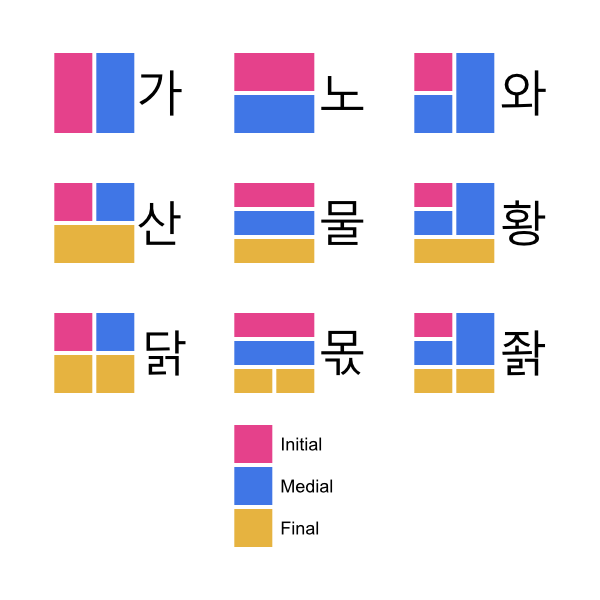
Stroke Order
The stroke order given is the proper stroke order that is taught in Korea to kids. It is important to
know because it is what affects their "cursive" handwriting. It's much easier to learn to understand
handwriting when you have the proper strokes ingrained. That said not everyone follows the stroke order
exactly for some characters but most Koreans do.
Hangul Vowels
The vowel system of Hangul is very interesting. There are 3 components: a horizontal line (earth/ground), a
vertical line (human) and a dot (sky).
These three combine to make all 21 vowels in Hangul. Modern Korean uses lines now instead of dots but if you
see historical dramas or sometimes old style advertising you may run across them.
Hangul letters look very similar to each other as a beginner so it may be confusing at first. Just try to
remember how hangul works. You will remember them all in time.
Vertical Vowels
The first of the two major types of vowels is the vertical vowel.
The base of the vertical vowel is... ㅣ
| Hangul |
Romanization |
Stroke |
Audio |
| ㅣ |
I |
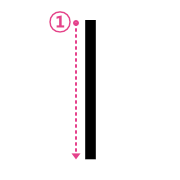 |
|
Now we can add a dot/line to make the next vowels. All vowels are made using the base and adding dots/lines
to represent sounds.
| Hangul |
Romanization |
Stroke |
Audio |
| ㅏ |
A |
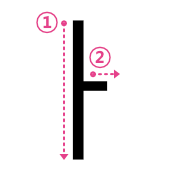 |
|
| ㅓ |
Eo |
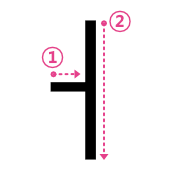 |
|
Syllable Block
For vertical vowels the vowel is placed to the right of the consonant.
- ㄱ + ㅣ = 기
- ㄱ + ㅏ = 가
- ㄱ + ㅓ = 거
Horizontal Vowels
The second of the two major types of vowels is the horizontal vowel.
The base of the horizontal vowel is... ㅡ
| Hangul |
Romanization |
Stroke |
Audio |
| ㅡ |
Eu |
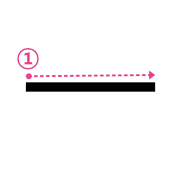 |
|
Remember we can add a dot/line to make new vowels.
| Hangul |
Romanization |
Stroke |
Audio |
| ㅗ |
O |
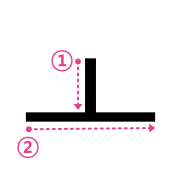 |
|
| ㅜ |
U |
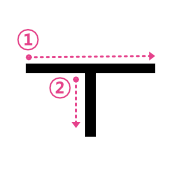 |
|
Syllable Block
For horizontal vowels the vowel is placed under the consonant
- ㄱ + ㅡ = 그
- ㄱ + ㅗ = 고
- ㄱ + ㅜ = 구
Y-Vowel Transformation
When you add a second line to the vowels you get their y combination.
| Hangul |
Romanization |
Stroke |
Audio |
| ㅑ |
Ya |
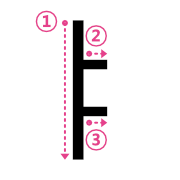 |
|
| ㅕ |
Yeo |
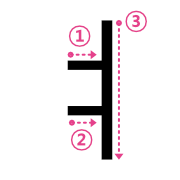 |
|
| ㅛ |
Yo |
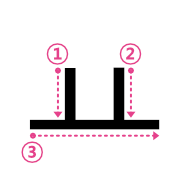 |
|
| ㅠ |
Yu |
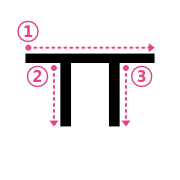 |
|
Syllable Block
These use the same syllable block as their base.
- ㄱ + ㅑ = 갸
- ㄱ + ㅕ = 겨
- ㄱ + ㅛ = 교
- ㄱ + ㅠ = 규
E-Vowel Combinations
E-Vowels always use two vertical lines.
| Individual |
Hangul |
Romanization |
Stroke |
Audio |
| ㅏ+ㅣ |
ㅐ |
Ae |
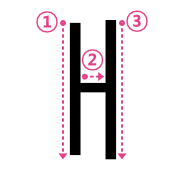 |
|
| ㅓ+ㅣ |
ㅔ |
E |
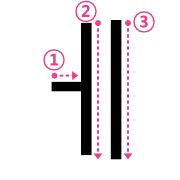 |
|
These two are pronounced the same. They used to be pronounced differently in the past but now use the same
pronunciation. If you're talkig to older people you might be able to hear the difference.
Syllable Block
These are placed like their base
Y-E-Vowel Combinations
If you were curious about adding another dot/line to the E-Vowels you absolutely can! Let's see what you get!
| Individual |
Hangul |
Romanization |
Stroke |
Audio |
| ㅐ |
ㅒ |
Yae |
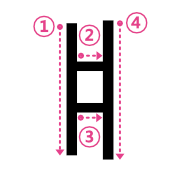 |
|
| ㅔ |
ㅖ |
Ye |
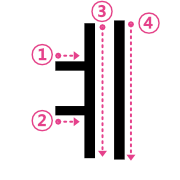 |
|
Just like ㅐ & ㅔ these two are pronounced the same.
Syllable Block
These use the same syllable block as their base.
W-Vowel Combinations
| Individual |
Hangul |
Romanization |
Stroke |
Audio |
| ㅡ+ㅣ |
ㅢ |
Eui |
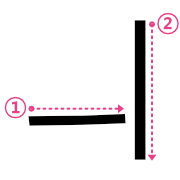 |
|
| ㅗ+ㅣ |
ㅚ |
Oe |
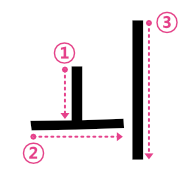 |
|
| ㅗ+ㅏ |
ㅘ |
Wa |
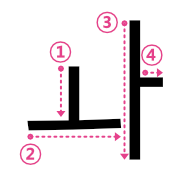 |
|
| ㅜ+ㅣ |
ㅟ |
Wi |
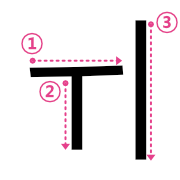 |
|
| ㅜ+ㅓ |
ㅝ |
Weo |
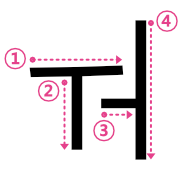 |
|
Syllable Block
These combinations are slightly different but totally guessable. The vowels still go where they should so
they
just push the consonant into the top left of the box the syllable block.
- ㄱ + ㅢ = 긔
- ㄱ + ㅚ = 괴
- ㄱ + ㅘ = 과
- ㄱ + ㅟ = 귀
- ㄱ + ㅝ = 궈
W-E Combinations
Almost there. W-E Combinations are the last of the combinations.
| Individual |
Hangul |
Romanization |
Stroke |
Audio |
| ㅗ+ㅐ |
ㅙ |
Wae |
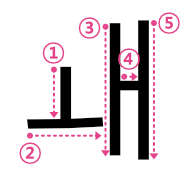 |
|
| ㅜ+ㅔ |
ㅞ |
We |
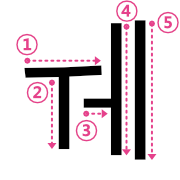 |
|
Syllable Block
Made just like the W-Vowel comibations.
Basic Consonants
Hangul has 19 consonants in total. We're going to focus on just 9 basic consonants because they are used to
build
the others. Consonants on their own don't make any sound. They have to be paired with a vowel so for the
alphabet ㅏ is used.
| Hangul |
Romanization |
Stroke |
Audio |
| ㄱ |
G |
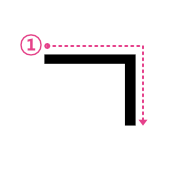 |
|
| ㄴ |
N |
 |
|
| ㄷ |
D |
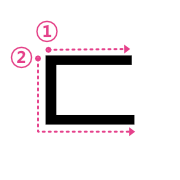 |
|
| ㄹ |
R / L |
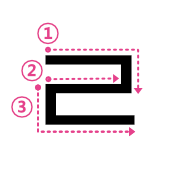 |
|
| ㅁ |
M |
 |
|
| ㅂ |
B |
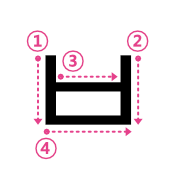 |
|
| ㅅ |
S / SH |
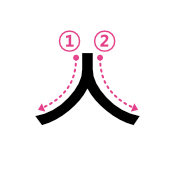 |
|
| ㅈ |
J |
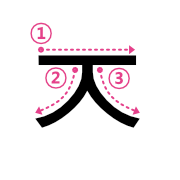 |
|
| ㅇ |
No consonant sound |
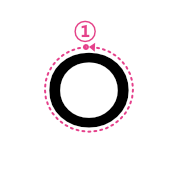 |
N/A |
Remember that the romanization is just a rough pronunciation. For example if you listen to ㅈ you'll notice it
sounds more similar to 'ch' not 'j'
What is ㅇ?
In Hangul just like you can't have a consonant on it's own you can't just write a vowel so you have
to use this blank consonant. You'll get a good explanation in a bit!
ㄹ Pronunciation
ㄹ is the hardest out of all the pronunciations for English speakers. We write it as either R or L
but its actually different from both of those sounds.
For the correct pronunciation touch the front of the ceiling of your mouth with your tongue and
move it down. This is unlike L where you are touching the back of your teeth.
Adding Dots/Lines to Consonants
Like we added dots/lines to the vowels we can also add them to the basic consonants to get new sounds.
| Basic |
New |
Romanization |
Stroke |
Audio |
| ㄱ |
ㅋ |
K |
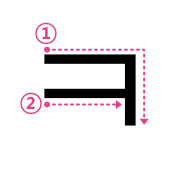 |
|
| ㄷ |
ㅌ |
T |
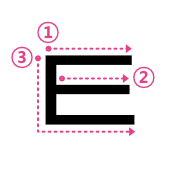 |
|
| ㅁ |
ㅍ |
P |
 |
|
| ㅈ |
ㅊ |
Ch |
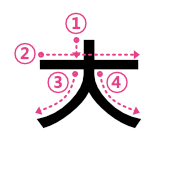 |
|
| ㅇ |
ㅎ |
H |
 |
|
Doubling Consonants
Some hangul letters have a twin!
These consonants are usually taught as being the plosive counterpart to their base. While they are plosive
their pronunciation is done by tensing the throat like when you say the 'e' in 'Ear'. It's going to take
some practice but I believe in you.
| Hangul |
Romanization |
Stroke |
Audio |
| ㄲ |
Gg |
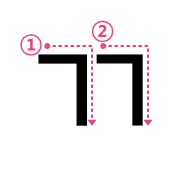 |
|
| ㄸ |
Dd |
 |
|
| ㅃ |
Bb |
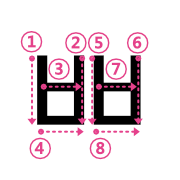 |
|
| ㅆ |
Ss |
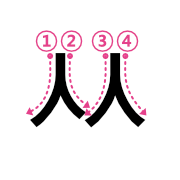 |
|
| ㅉ |
Jj |
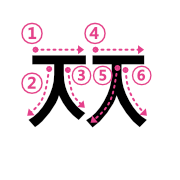 |
|
Batchim
The last step to learning Korean is learning about the Batchim. Batchim is what can make Korean hard to
pronounce
and listen to at first. A batchim is the final consonant of a syllable block. So not all syllables have
batchim.
When a consonant ends in a syllable block it makes a different sound than the initial sound. So let's go
over
the consonants and learn their endind sounds. When writing the syllable block just squeze the characters up
a bit to make room to write underneath.
Double Batchim
There are some words that have two batchim. Like 닭. There are only a set number of these and they'll all be
shown below as we learn the pronunciation.
Batchim Basic Pronunciation
Batchim can be hard for English learners. Essentially what happens is your mouth position goes to start
pronouncing the consonant but you make a hard stop.
There are 7 ways that batchim can sound at the end.
ㄱ, ㅋ, ㄲ, ㄳ, ㄺ
Will end with the ㄱ sound
| Korean |
Pronunciation |
Audio |
| 국 |
국 |
|
| 부엌 |
부억 |
|
| 닦 |
닥 |
|
| 몫 |
목 |
|
| 닭 |
닥 |
|
ㄴ, ㄵ, ㄶ
Will end with the ㄴ sound
| Korean |
Pronunciation |
Audio |
| 반 |
반 |
|
| 앉 |
안 |
|
| 많 |
만 |
|
ㄷ, ㅌ, ㅅ, ㅆ, ㅈ, ㅊ, ㅎ
Will end with a ㄷ sound
When ㅎ ends a syllable block it always has a sound change so it doesn't occur in Korean where it would make
the ㄷ sound.
| Korean |
Pronunciation |
Audio |
| 받 |
받 |
|
| 같 |
갇 |
|
| 맛 |
맏 |
|
| 있 |
읻 |
|
| 낮 |
낟 |
|
| 꽃 |
꼳 |
|
| ㅎ |
Doesn't occur |
ㄹ, ㄼ, ㄾ, ㅀ, ㄽ
Will end with a ㄹ sound
ㄾ & ㄽ are rare, between both of them I could only find four words.
| Korean |
Pronunciation |
Audio |
| 칼 |
칼 |
|
| 밟 |
발 |
|
| 핥 |
할 |
|
| 잃 |
일 |
|
| 곬 |
골 |
|
ㅁ, ㄻ
Will end with a ㅁ sound
| Korean |
Pronunciation |
Audio |
| 감 |
감 |
|
| 삶 |
삼 |
|
ㅂ, ㅍ, ㅄ, ㄿ
Will end with a ㅂ sound
ㄿ is rare I could only find two words - 읊다 and 옲다
| Korean |
Pronunciation |
Audio |
| 밥 |
밥 |
|
| 잎 |
입 |
|
| 없 |
업 |
|
| 읊다 |
읍 |
|
ㅇ
As you know from above does not make a sound in the initial position. However when it is the final
consonant it makes a 'ng' sound.
| Korean |
Pronunciation |
Audio |
| 강 |
강 |
|
| 공 |
공 |
|
Batchim Pronunciation Changes
Batchim may seem easy but there are some sound changes we need to learn that happen when we have words and
syllables next to each other. These changes are based on the sounds they make in their final position.
Batchim + ㅇ
If the next syllable block starts with ㅇ. Then the batchim sound moves forward to the next syllable. There
are always exceptions so just be prepared (eg. 웃어른 > 우더른 but 웃어요 > 우서요).
| Korean |
Pronunciation |
Audio |
| 국어 |
구거 |
|
| 단어 |
다너 |
|
| 닫아 |
다다 |
|
| 달아 |
다라 |
|
| 감이 |
가미 |
|
| 밥은 |
바븐 |
|
| 맛없 |
마덥 |
|
| 강아지 |
강아지 |
|
| 잊어 |
이저 |
|
| 꽃이 |
꼬치 |
|
| 부엌에 |
부어게 |
|
| 같아 |
가타 |
|
| 깊은 |
기픈 |
|
ㅎ + ㄱ,ㄷ,ㅂ,ㅈ
They will sound like their strong consonants
| Korean |
Pronunciation |
Audio |
| 놓고 |
노코 |
|
| 낳다 |
나타 |
|
| 그렇지 |
그러치 |
|
ㅎ + ㄴ
ㅎ will sound like ㄴ
| Korean |
Pronunciation |
Audio |
| 놓는 |
논는 |
|
ㅎ + ㅇ
No sound is made
| Korean |
Pronunciation |
Audio |
| 쌓은 |
싸은 |
|
ㄷ + 이, 히
Sounds like 치
| Korean |
Pronunciation |
Audio |
| 곧이 |
고치 |
|
| 닫히 |
다치 |
|
| 같이 |
가치 |
|
| 꽃이 |
꼬치 |
|
ㄱ + ㄴ or ㅁ
They will be pronounced as ㅇ
| Korean |
Pronunciation |
Audio |
| 작년 |
장년 |
|
| 깎는 |
깡는 |
|
| 한국말 |
한궁말 |
|
| 부엌만 |
부엉만 |
|
ㅂ + ㄴ or ㅁ
They will sound like ㅁ
| Korean |
Pronunciation |
Audio |
| 합니다 |
함니다 |
|
| 십만 |
심만 |
|
| 앞니 |
암니 |
|
| 앞문 |
암문 |
|
ㄴ + ㄹ or ㄹ + ㄴ
ㄴ will sound like ㄹ
| Korean |
Pronunciation |
Audio |
| 안리 |
알리 |
|
| 날노 |
날로 |
|
ㅇ, ㅁ + ㄹ
ㄹ will sound like ㄴ
| Korean |
Pronunciation |
Audio |
| 종로 |
종노 |
|
| 음료 |
음뇨 |
|
ㄹ + ㄱ,ㄷ,ㅂ,ㅅ,ㅈ
They will sound like their tense consonants
| Korean |
Pronunciation |
Audio |
| 일자리 |
일짜리 |
|
ㅅ + ㅣ,ㅑ,ㅕ,ㅖ,ㅒ,ㅛ,ㅠ
Sounds more like "Sh" than "S"
| Korean |
Pronunciation |
Audio |
| 시 |
시 |
|
| 샤 |
샤 |
|
| 셔 |
셔 |
|
| 셰 |
셰 |
|
| 새 |
새 |
|
| 쇼 |
쇼 |
|
| 슈 |
슈 |
|
ㅂ + ㄹ or ㄱ + ㄹ
ㅂ sounds like ㅁ and ㄹ will sound like ㄴ, ㄱ will sound like ㅇ
| Korean |
Pronunciation |
Audio |
| 합리 |
함니 |
|
| 맥락 |
맹낙 |
|
Double Batchim + ㅇ
If the next syllable block starts with ㅇ. Then the batchim moves its second consonant to the ㅇ. Then follow
any sound changes you learned from above (eg. 읽어 > 일거 > 일꺼).
This is not the case with ㄲ or ㅆ. It's because they're considered one character/sound instead of two put
together.
| Korean |
Pronunciation |
Audio |
| 닦아 |
다까 |
|
| 몫이 |
목시 |
|
| 읽어 |
일꺼 |
|
| 앉아 |
안자 |
|
| 않아 |
안아 |
|
| 있어 |
이써 |
|
| 넓어 |
널뻐 |
|
| 핥아 |
할타 |
|
| 잃어 |
일어 |
|
| 곬을 |
골쓸 |
|
| 삶은 |
살믄 |
|
| 읊아 |
을파 |
|
| 값이 |
갑시 |
|








































